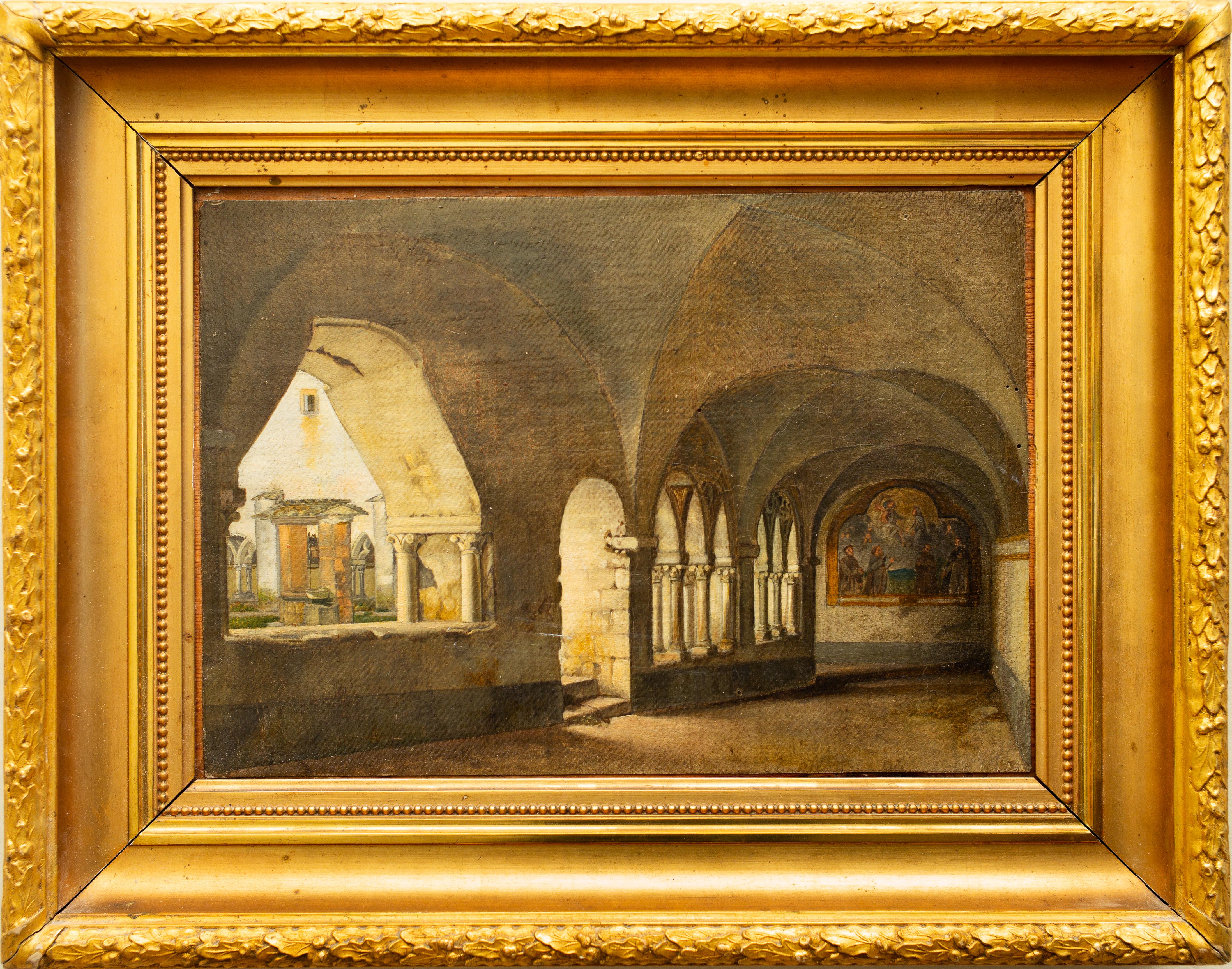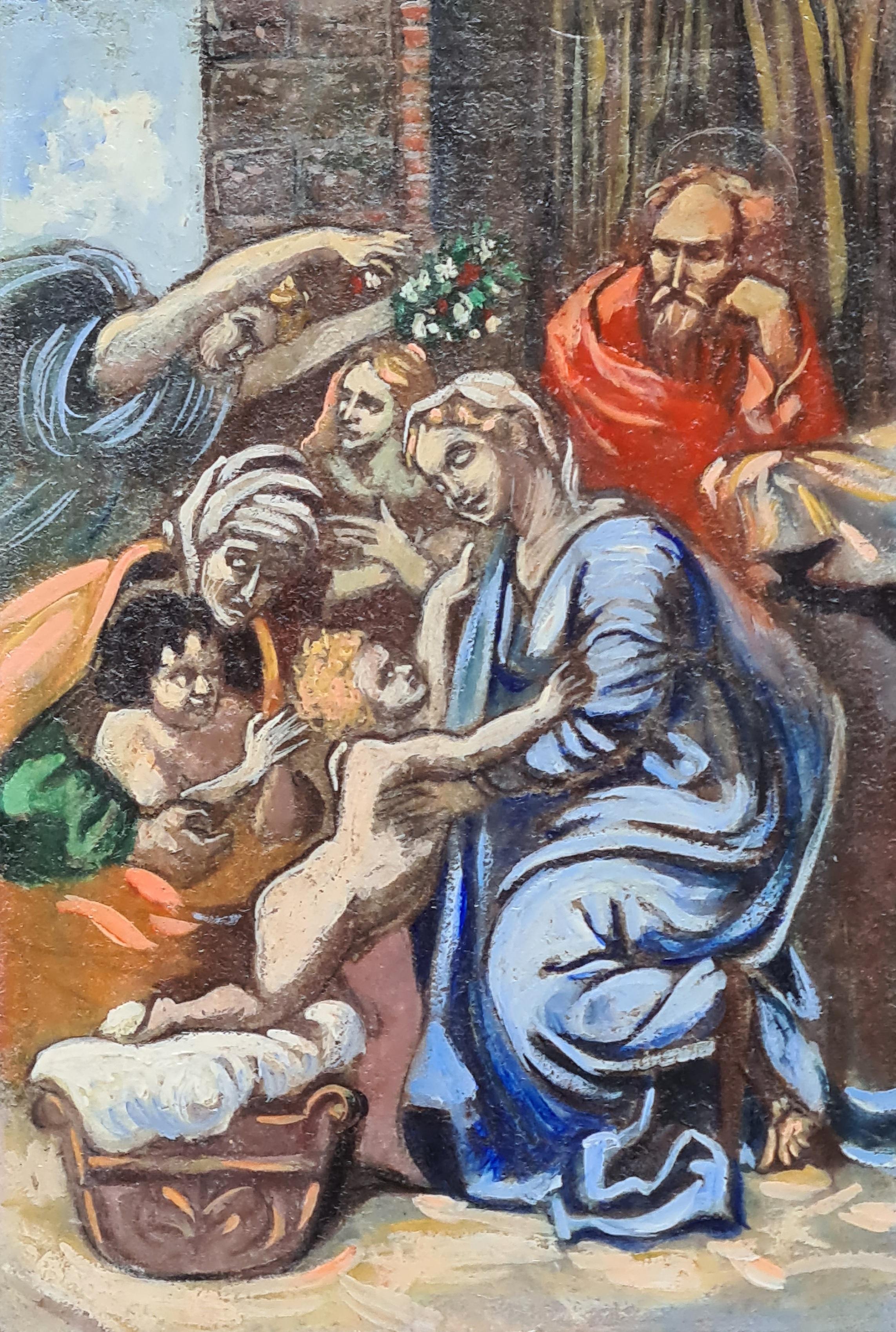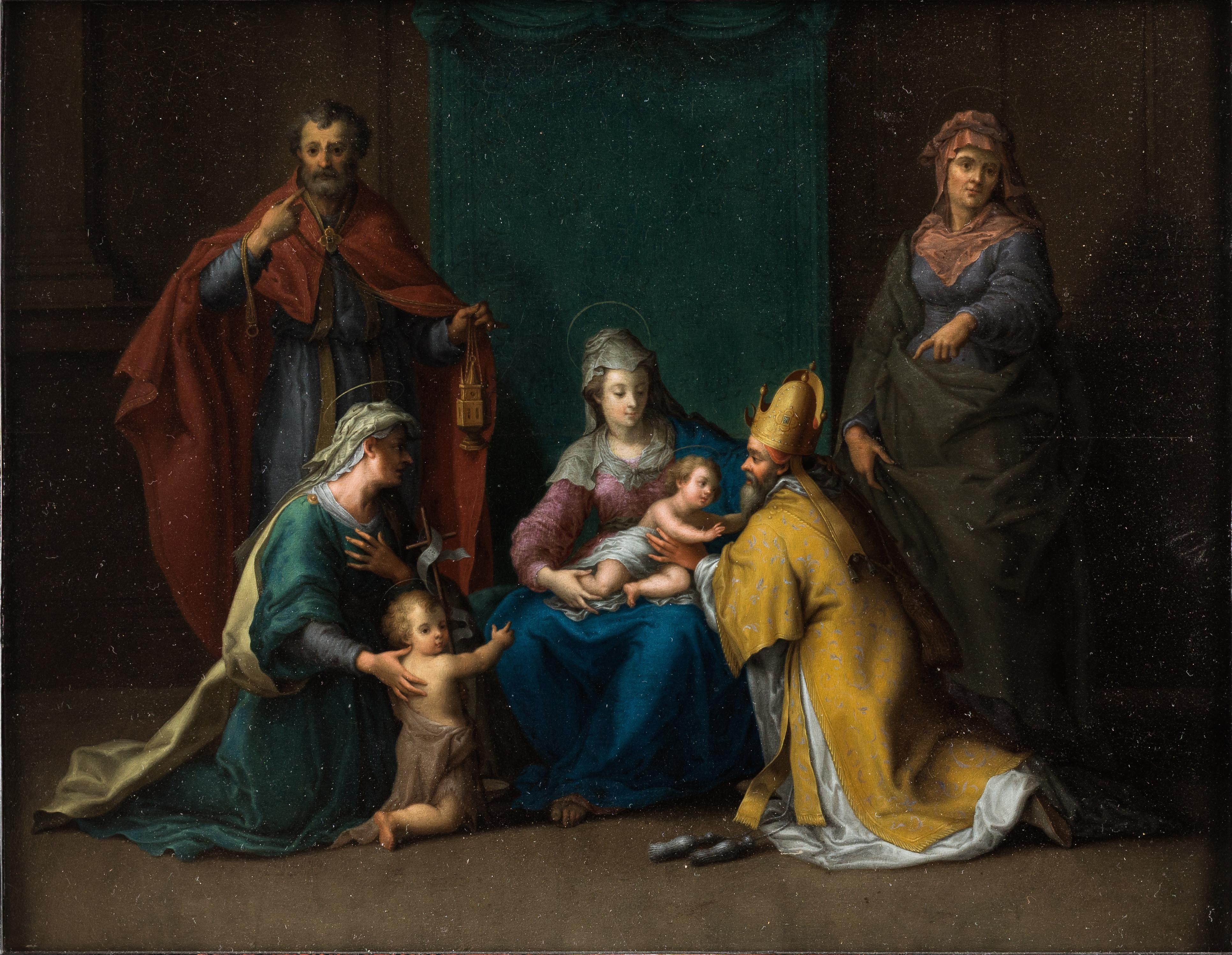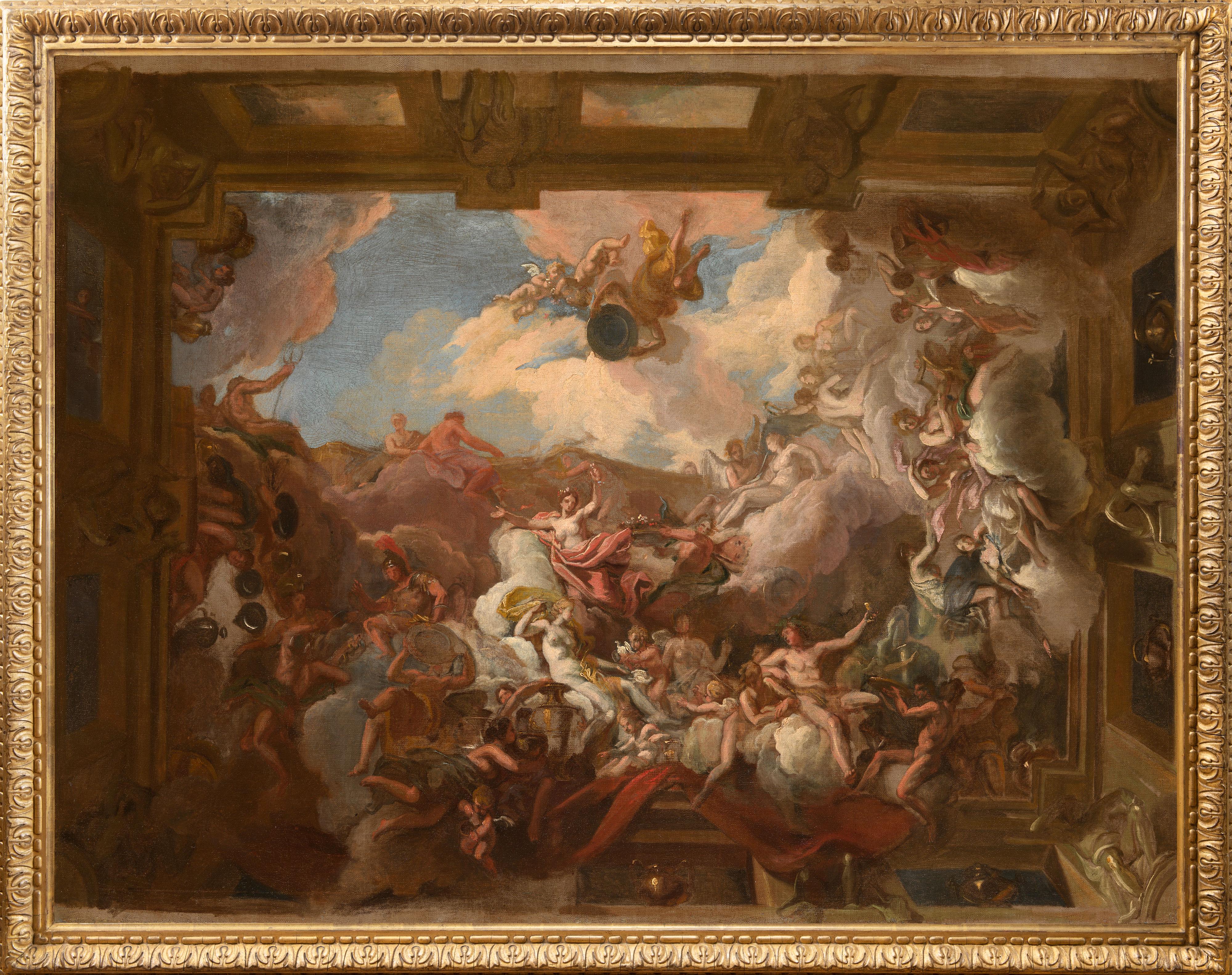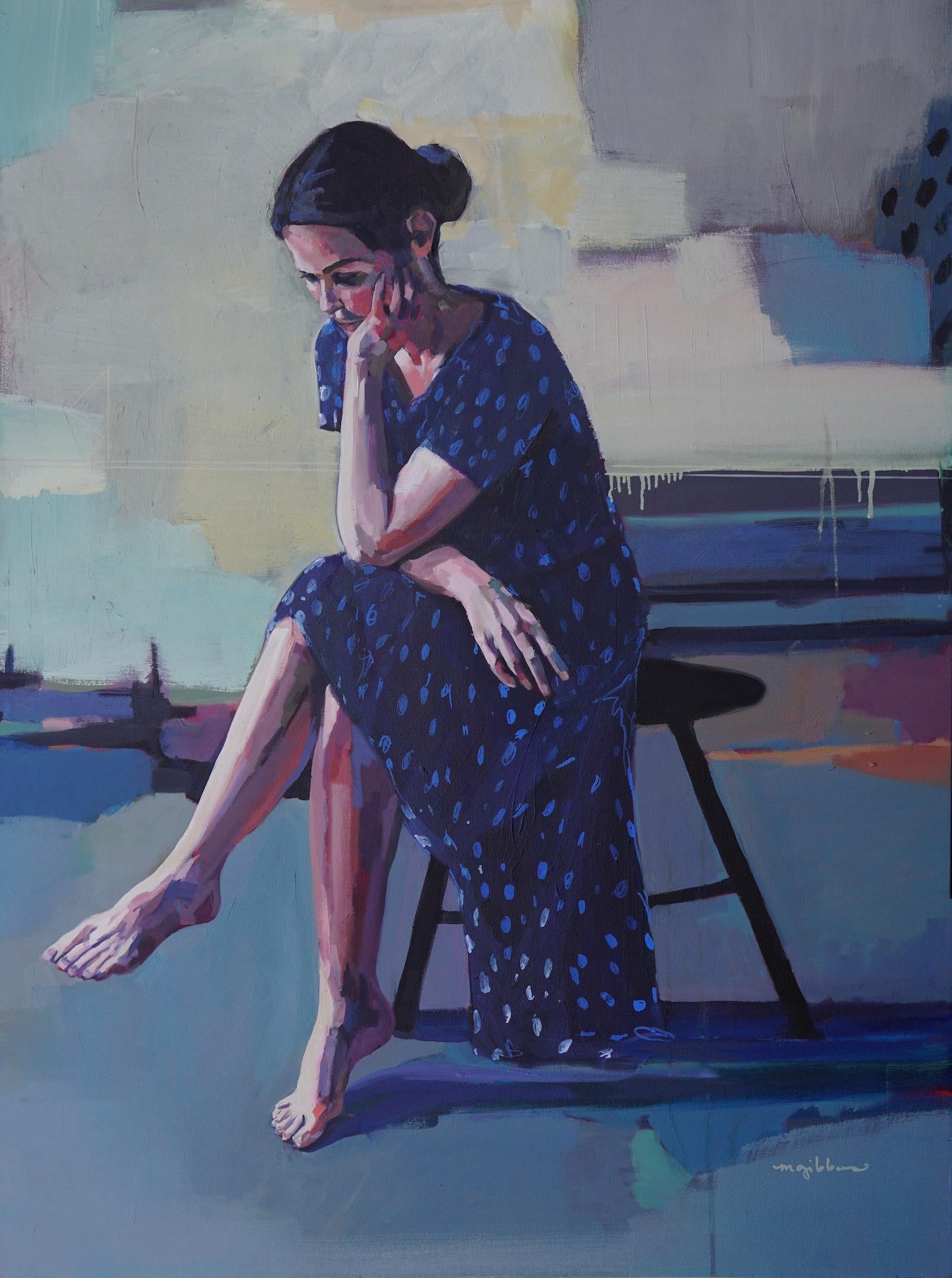Items Similar to Joseph and Potiphar's Wife
Want more images or videos?
Request additional images or videos from the seller
1 of 5
Antonio PalmaJoseph and Potiphar's Wifec. 1545-50
c. 1545-50
About the Item
Provenance:
Palazzo Pisani at San Stefano, Venice
Mrs. F. Craighead (possibly Mrs. Fay Stinson Craighead, Evansville, Indiana)
Sale, Sotheby Parke Bernet, New York, 7 June 1978, lot 310, as Bonifazio Veronese
Daniel M. Friedenberg, New York, until 2011; and by descent to:
Russell Friedenberg, until 2014
Literature:
Giuseppe Pavanello, Gli Inventari di Pietro Edwards nella Biblioteca del Seminario Patriarcale di Venezia, Venice 2006, pp. 132, 140, as no. 10 in Pietro Edwards’ inventory of the Palazzo Pisani: “Giuseppe che fugge dalla moglie di Pitifarre” by Bonifacio Veronese.
Philip Cottrell and Peter Humfrey, Bonifacio de’ Pitati, (forthcoming), cat. no. 166h.
Antonio Palma is the least well-known member of the illustrious Palma family of Venetian painters of the 16th century. He was the nephew of Jacopo Palma—Palma il Vecchio—and upon his uncle’s death in 1528, he began to work with Palma Vecchio’s principal student and the inheritor of the elder artist’s studio, Bonifazio de’ Pitati (Bonifazio Veronese). Antonio worked with Bonifazio as his principal assistant and right-hand man until Bonifazio’s death in 1553, after which he continued his independent career. He married a niece of his master, and their second son, Jacopo, born in 1648, would achieve fame as Palma il Giovane.
The present painting was long considered a work by Bonifazio, but recent scholarship has established that it is in fact by Antonio Palma, working in association with his master. The painting formed part of a room decoration, probably painted for the Pisani family, that was recorded in the Palazzo Pisani in Campo Santo Stefano, Venice, in 1802. In their forthcoming monograph on Bonifazio Veronese, Philip Cottrell and Peter Humfrey have associated nine like-sized canvases with the project, including our Joseph and Potiphar’s Wife. One of these, Mucius Scaevola before Lars Porsena, is in the Pinacoteca Egidio Martini at Ca’ Rezzonico in Venice. The whereabouts of the remaining seven is at present unknown, although they remained together with the present work until the 1970s. Humfrey and Cottrell date these paintings to ca. 1545-50 and consider them painted by a single artist active in Bonifazio’s workshop, whom they identify as Antonio Palma.
The painting dramatically illustrates the biblical tale of Joseph and Potiphar’s Wife. As related in Genesis, Joseph, when captive in Egypt, had been sold to Potiphar, the captain of the Pharaoh’s Guard, in whose house he lived and whom he served as a trusted majordomo. Potiphar’s unnamed wife repeatedly attempted to seduce the handsome Joseph, who remained loyal to his master. One day while alone in the house with Joseph, “she caught him by his garment, saying, Lie with me: and he left his garment in her hand, and fled” (Genesis 39:15). So rejected, she then accused Joseph of attempted rape, brandishing the cloak he had abandoned as evidence against him. Potiphar then apprehended Joseph and imprisoned him.
The principal part of the composition depicts Potiphar’s wife, seated on her large bed, desperately reaching for Joseph and holding the red cloak that Joseph, his arms outstretched in alarm, had draped across him. Just outside to the right, through an open portico, the turbaned Potiphar is seen directing the accused Joseph to prison. He is still attired in his blue garment, but his shoulders are now slumped in resignation as he is being marched by two guards towards the prison, the door to which a helmeted jailer is opening with a key. The story is brilliantly, almost cinematically told with clarity and directness as the narrative plays out across the canvas.
Dr. Peter Humfrey has kindly shared a catalogue entry on the series from his forthcoming monograph on Bonifazio Veronese, co-authored with Philip Cottrell, which is available upon request.
- Creator:Antonio Palma (1515 - 1575)
- Creation Year:c. 1545-50
- Dimensions:Height: 10.5 in (26.67 cm)Width: 35 in (88.9 cm)
- Medium:
- Movement & Style:
- Period:
- Condition:
- Gallery Location:New York, NY
- Reference Number:1stDibs: LU1026202812

About the Seller
5.0
Recognized Seller
These prestigious sellers are industry leaders and represent the highest echelon for item quality and design.
Established in 1997
1stDibs seller since 2012
17 sales on 1stDibs
Typical response time: 11 hours
- ShippingRetrieving quote...Ships From: New York, NY
- Return PolicyThis item cannot be returned.
More From This SellerView All
- St. Vincent Ferrer Preaching to the People of SalamancaLocated in New York, NYProvenance: Private Collection, New Jersey The present painting depicts Saint Vincent Ferrer preaching from a raised pulpit to a group of seven peopl...Category
15th Century and Earlier Renaissance Figurative Paintings
MaterialsOil, Wood Panel
- Leisure Moments (Interior Scene)By Julius SchmidLocated in New York, NYCharming watercolor of an intimate family scene in beautiful painted period frame. Signed in the lower right-hand corner.Category
Early 19th Century Paintings
MaterialsWatercolor
- An Architectural Capriccio with the Preaching of an ApostleBy Giovanni Paolo PaniniLocated in New York, NYProvenance: Santambrogio Antichità, Milan; sold, 2007 to: Filippo Pernisa, Milan; by whom sold, 2010, to: Private Collection, Melide, Switzerland De Primi Fine Art, Lugano, Switzerland; from whom acquired, 2011 by: Private Collection, Connecticut (2011-present) Literature: Ferdinando Arisi, “Ancora sui dipinti giovanili del Panini,” Strenna Piacentina (Piacenza, 2009): pp. 48, 57, 65, fig. 31, as by Panini Ferdinando Arisi, “Panini o Ghisolfi o Carlieri? A proposito dei dipinti giovanili,” Strenna Piacentina, (Piacenza, 2010), pp. 100, 105, 116, fig. 101, as an early work by Panini, a variant of Panini’s painting in the Museo Cristiano, Esztergom, Hungary. This architectural capriccio is one of the earliest paintings by Giovanni Paolo Panini, the preeminent painter of vedute and capricci in 18th-century Rome. The attribution to Panini has been endorsed by Ferdinando Arisi, and a recent cleaning of the painting revealed the artist’s signature in the lower right. Like many of his fellow painters working in Rome during his day, Panini was not a native of the Eternal City. He first trained as a painter and stage designer in his hometown of Piacenza and moved to Rome at the age of 20 in November 1711 to study figure painting. Panini joined the workshop of Benedetto Luti (1666-1724) and from 1712 was living on the Piazza Farnese. Panini, like many before and after him, was spellbound by Rome and its classical past. He remained in the city for the rest of his career, specializing in depicting Rome’s most important monuments, as well as creating picturesque scenes like this one that evoked the city’s ancient splendor. The 18th century art historian Lione Pascoli, who likely knew Panini personally, records in his 1730 biography of the artist that when Panini came to Rome, he was already “an excellent master and a distinguished painter of perspective, landscape, and architecture.” Panini’s earliest works from this period still show the evidence of his artistic formation in Piacenza, especially the influence of the view painter Giovanni Ghisolfi (1623-1683). However, they were also clearly shaped by his contact in Rome with the architectural capricci of Alberto Carlieri...Category
18th Century Old Masters Figurative Paintings
MaterialsCanvas, Oil
- Holy Family with the Infant St. John the BaptistLocated in New York, NYLubin Baugin (Pithiviers 1610 – 1663 Paris) Holy Family with the Infant Saint John the Baptist Oil on canvas 22 x 42 ¼ inches (55.9 x 107.3 cm) Provenance: Marcello and Carlo ...Category
17th Century Old Masters Figurative Paintings
MaterialsCanvas, Oil
- Julius Caesar on HorsebackBy Antonio TempestaLocated in New York, NYProvenance: Private Collection, South America Antonio Tempesta began his career in Florence, working on the decoration of the Palazzo Vecchio under the direction of Giorgio Vasari. He was a pupil first of Santi di Tito...Category
16th Century Old Masters Paintings
MaterialsOil, Canvas
- Madonna and Child with Angels in the CloudsLocated in New York, NYProvenance: Charles H. and Virginia Baldwin, Claremont, Colorado Springs, Colorado ca. 1907-1934; thence by descent until sold in 1949 to: Charles Blevins Davis, Claremont (renamed Trianon), Colorado Springs 1949 -until gifted in 1952 to: The Poor Sisters of Saint Francis, Trianon, Colorado Springs, 1952 until acquired, 1960, by: John W. Metzger, Trianon, renamed as the Trianon School of Fine Arts, Colorado Springs, 1960-1967; when transferred to: The Metzger Family Foundation, Trianon Art Museum, Denver, 1967 - 2004; thence by descent in the Metzger Family until 2015 Exhibited: Trianon Art Museum, Denver (until 2004) The present work is a spectacular jewel-like canvas by Amigoni, rich in delicate pastel colors, most likely a modello for an altarpiece either lost or never painted. In it the Madonna stands firmly upon a cloud in the heavens, her Child resting on a delicate veil further supported by a cloud, as he gently wraps his arm around his mother’s neck. From above angels prepare to lower flowers and a wreath, while other angels and seraphim surrounding the two joyfully cavort. Dr. Annalisa Scarpa, author of the forthcoming monograph on Jacopo Amigoni...Category
18th Century and Earlier Figurative Paintings
MaterialsCanvas, Oil
You May Also Like
- The Cloister of Santa Maria del Paradiso, Viterbo. Attributed to Ditlev MartensLocated in Stockholm, SEDitlev Martens was a Danish artist who lived from 1795 to 1864, creating a series of impressive paintings that continue to captivate and inspire viewers today. One of his beautiful c...Category
1820s Renaissance Interior Paintings
MaterialsCanvas, Oil
- Renaissance Style Oil on Card, The Holy Family & Saint Elizabeth, after RaphaelBy (after) Raphael (Raffaello Sanzio da Urbino)Located in Cotignac, FRLate 20th century oil on card painting of the Holy Family after the work of Raphael. Titled and with initials to the back of the card. A charming academic study of the famous painti...Category
Late 20th Century Renaissance Figurative Paintings
MaterialsCardboard, Oil
- Sacra Conversazione, Maria, Christ, Old Master, Religious, Baroque Painting, artLocated in Greven, DEAttributed to Peter Candid / Pieter de Witte (Bruges c. 1540 - 1628 Munich) Sacra Conversazione Oil on wood, 29 x 37 cm The painter, sculptor and architect Peter Candid, known in Italy as Pietro Candido, was born in Bruges between 1540 and 1548. In the 1560s he stayed in Florence, where he worked in the workshop of Giorgio Vasari, with whom he collaborated on a number of commissions for the House of Medici. After a brief stay in Volterra, he went to Munich in 1586. For the next 42 years, until his death, he remained court painter to Duke William V...Category
17th Century Renaissance Figurative Paintings
MaterialsPanel, Oil
- Circa 1500 Italian Renaissance Oil Painting on Copper St. Francis of AssisiLocated in Cirencester, GloucestershireSt. Francis of Assisi Italian School, circa 1500 oil paint on copper, unframed copper: 6.75 x 10 inches provenance: private collection, Loire Valley, France condition: for a work tha...Category
15th Century and Earlier Renaissance Figurative Paintings
MaterialsCopper
- 18th century oil sketches for a Baroque interior - a pairLocated in London, GBA FEAST OF THE GODS WITH VENUS AND BACCHUS Collections: With Appleby Brothers, London, June 1957; Hazlitt, Gooden & Fox, London, 1961; John and Eileen Harris, acquired from the above, to 2015. Literature: Jacob Simon and Ellis Hillman, English Baroque Sketches: The Painted Interior in the Age of Thornhill, 1974, cat. no.12 (as by Louis Laguerre); Elizabeth Einberg (ed.), Manners and Morals: Hogarth and British Painting, 1700-1760, exh. cat., London (Tate Gallery), 1987, cat. no.10 (as by Louis Laguerre); Tabitha Barber and Tim Bachelor, British Baroque: Power and Illusion, exh. cat., London (Tate Britain), 2020. Exhibited: Twickenham, Marble Hill House, English Baroque Sketches: The Painted Interior in the Age of Thornhill, 1974, no.12 (as by Louis Laguerre); London, Tate Gallery, Manners and Morals: Hogarth and British Painting, 1700-1760, 1987, no.10 (as by Louis Laguerre); London, Tate Britain, British Baroque: Power and Illusion, cat. no 92, 2020. CUPID AND PSYCHE BEFORE JUPITER Collections: With Appleby Brothers, London, June 1957; Hazlitt, Gooden & Fox, London, 1961; Anthony Hobson, acquired from the above, to 2015. These recently re-united paintings are the most ambitious surviving baroque ceiling sketches made in Britain in the early eighteenth century. From the Restoration until the rise of Palladianism in the 1720s decorative history painting formed the preeminent artistic discipline in Britain. It was a field dominated by Continental artists including the Italian Antonio Verrio and the Frenchmen Louis Laguerre and Louis Chéron...Category
Early 18th Century Baroque Figurative Paintings
MaterialsCanvas, Oil
- SerenaLocated in Salt Lake City, UT"Serena" by Megan Gibbons, oil on canvas, 48 x 36 inches, (gallery wrapped canvas) $3500. - My work focuses on the meaningfulness in ordinary moments. T...Category
2010s Other Art Style Figurative Paintings
MaterialsCanvas, Oil
